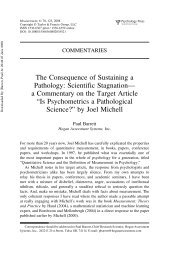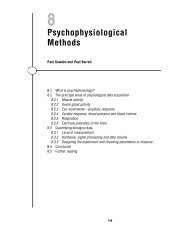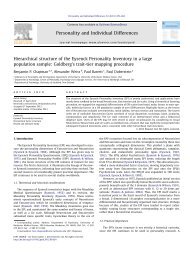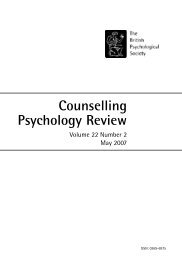Dimensions of variation on the CORE-OM - Paul Barrett
Dimensions of variation on the CORE-OM - Paul Barrett
Dimensions of variation on the CORE-OM - Paul Barrett
Create successful ePaper yourself
Turn your PDF publications into a flip-book with our unique Google optimized e-Paper software.
Copyright © The British Psychological SocietyReproducti<strong>on</strong> in any form (including <strong>the</strong> internet) is prohibited without prior permissi<strong>on</strong> from <strong>the</strong> Society<str<strong>on</strong>g>Dimensi<strong>on</strong>s</str<strong>on</strong>g> <str<strong>on</strong>g>of</str<strong>on</strong>g> <str<strong>on</strong>g>variati<strong>on</strong></str<strong>on</strong>g> <strong>on</strong> <strong>the</strong> <strong>CORE</strong>-<strong>OM</strong> 187were very acceptable. Principal comp<strong>on</strong>ent analyses showed a large proporti<strong>on</strong> <str<strong>on</strong>g>of</str<strong>on</strong>g> <strong>the</strong>variance in <strong>the</strong> first comp<strong>on</strong>ent (e.g. 38% for <strong>the</strong> n<strong>on</strong>-clinical sample).In both clinical and n<strong>on</strong>-clinical samples, oblique rotati<strong>on</strong> <str<strong>on</strong>g>of</str<strong>on</strong>g> three comp<strong>on</strong>ents gavenegatively keyed and positively keyed n<strong>on</strong>-risk items, with a third comp<strong>on</strong>ent for riskitems. The separati<strong>on</strong> was perfect in <strong>the</strong> n<strong>on</strong>-clinical sample but slightly compromisedin <strong>the</strong> clinical sample. The differentiati<strong>on</strong> into factors for positively and negativelyworded items (NW) suggests an alternative model for <strong>CORE</strong>-<strong>OM</strong> with two methodfactors regressing <strong>on</strong> to a general factor latent for psychological distress.C<strong>on</strong>vergent correlati<strong>on</strong>s <str<strong>on</strong>g>of</str<strong>on</strong>g> <strong>the</strong> <strong>CORE</strong>-<strong>OM</strong> scores against various measures wereexplored in several clinical samples. These were: <strong>the</strong> four scales <str<strong>on</strong>g>of</str<strong>on</strong>g> <strong>the</strong> 28-item GeneralHealth Questi<strong>on</strong>naire (GHQ; Goldberg & Hillier, 1979), <strong>the</strong> original and sec<strong>on</strong>d versi<strong>on</strong>s<str<strong>on</strong>g>of</str<strong>on</strong>g> <strong>the</strong> Beck Depressi<strong>on</strong> Inventory (BDI; Beck, Steer, & Brown, 1996; Beck, Ward,Mendels<strong>on</strong>, Mock, & Erbaugh, 1961), <strong>the</strong> Beck Anxiety Inventory (BAI; Beck, Epstein,Brown, & Steer, 1988), <strong>the</strong> Brief Symptom Inventory (BSI; Derogatis & Melisaratos,1983), <strong>the</strong> revised versi<strong>on</strong> <str<strong>on</strong>g>of</str<strong>on</strong>g> <strong>the</strong> Symptom Checklist-90-R (Derogatis, 1983) and <strong>the</strong> 32-item versi<strong>on</strong> <str<strong>on</strong>g>of</str<strong>on</strong>g> <strong>the</strong> Inventory <str<strong>on</strong>g>of</str<strong>on</strong>g> Interpers<strong>on</strong>al Problems (IIP-32; Barkham, Hardy, &Startup, 1996; Horowitz, Rosenberg, Baer, Ureno, & Villasenor, 1988). There werestr<strong>on</strong>g, positive correlati<strong>on</strong>s <str<strong>on</strong>g>of</str<strong>on</strong>g> <strong>the</strong> referential measures with <strong>the</strong> <strong>CORE</strong>-<strong>OM</strong> scales, andsome evidence for discriminant validity where <strong>the</strong> str<strong>on</strong>gest correlati<strong>on</strong> was with <strong>the</strong>scale that would have been expected (e.g. IIP-32 with functi<strong>on</strong>ing). However, for <strong>on</strong>ly<strong>on</strong>e out <str<strong>on</strong>g>of</str<strong>on</strong>g> 11 comparis<strong>on</strong>s was <strong>the</strong> effect statistically significant (BAI with problems,N ¼ 218, r ¼ :68; compared with BAI with functi<strong>on</strong>ing, N ¼ 218, r ¼ :55; correlati<strong>on</strong>difference p , :05). Thus discriminant validity was not str<strong>on</strong>g in relati<strong>on</strong> to <strong>the</strong> hugegeneral covariance between all <str<strong>on</strong>g>of</str<strong>on</strong>g> <strong>the</strong> measures. The <strong>CORE</strong>-<strong>OM</strong> risk items were found tohave str<strong>on</strong>g, positive correlati<strong>on</strong>s with a <strong>the</strong>rapist rating <str<strong>on</strong>g>of</str<strong>on</strong>g> risk in a student counsellingclient sample.Finally, although <strong>CORE</strong>-<strong>OM</strong> might have been expected to be useful for testing <strong>the</strong>phase model <str<strong>on</strong>g>of</str<strong>on</strong>g> psycho<strong>the</strong>rapy, Shapiro et al. (2001) found no support for <strong>the</strong> phasemodel <str<strong>on</strong>g>of</str<strong>on</strong>g> change based <strong>on</strong> repeated measurement in psycho<strong>the</strong>rapy patients using<strong>CORE</strong>-<strong>OM</strong> as <strong>the</strong> change measure. The pattern <str<strong>on</strong>g>of</str<strong>on</strong>g> str<strong>on</strong>g correlati<strong>on</strong>s between <strong>the</strong>domains was repeated at each measurement point. Notwithstanding problems with <strong>the</strong>phase model (Joyce, Ogrodniczuk, Piper, & McCallum, 2002) <strong>the</strong> stability in correlati<strong>on</strong>sbetween <strong>the</strong> domains over time raises <strong>the</strong> questi<strong>on</strong> as to whe<strong>the</strong>r <strong>the</strong> <strong>CORE</strong>-<strong>OM</strong>domains covary too str<strong>on</strong>gly to test it.In summary, <strong>the</strong> initial work <strong>on</strong> <strong>the</strong> <strong>CORE</strong>-<strong>OM</strong> supports its utility as a pragmaticmeasure, most str<strong>on</strong>gly supporting separati<strong>on</strong> <str<strong>on</strong>g>of</str<strong>on</strong>g> <strong>the</strong> risk items from <strong>the</strong> remaining 28items. However, differentiati<strong>on</strong> between <strong>the</strong> three domains (subjective well-being,problems, and functi<strong>on</strong>ing) remains to be determined. The purpose <str<strong>on</strong>g>of</str<strong>on</strong>g> this study is toreport a detailed explorati<strong>on</strong> <str<strong>on</strong>g>of</str<strong>on</strong>g> <strong>CORE</strong>-<strong>OM</strong> by comparing models for its psychometricstructure to determine which is optimal. It also assesses whe<strong>the</strong>r <strong>the</strong> four self-harm riskitems have psychometric claims to form a scale ra<strong>the</strong>r than be used <strong>on</strong>ly as clinical flags.MethodData setThe study used completed questi<strong>on</strong>naires from clients referred to counselling andpsychological <strong>the</strong>rapy services in <strong>the</strong> UK.Of 2,277 cases, data were missing for gender in eight cases. In <strong>the</strong> remaining 2,269cases, <strong>the</strong> distributi<strong>on</strong> <str<strong>on</strong>g>of</str<strong>on</strong>g> missing data was 1,919 cases (84%) with no missing data, 221












